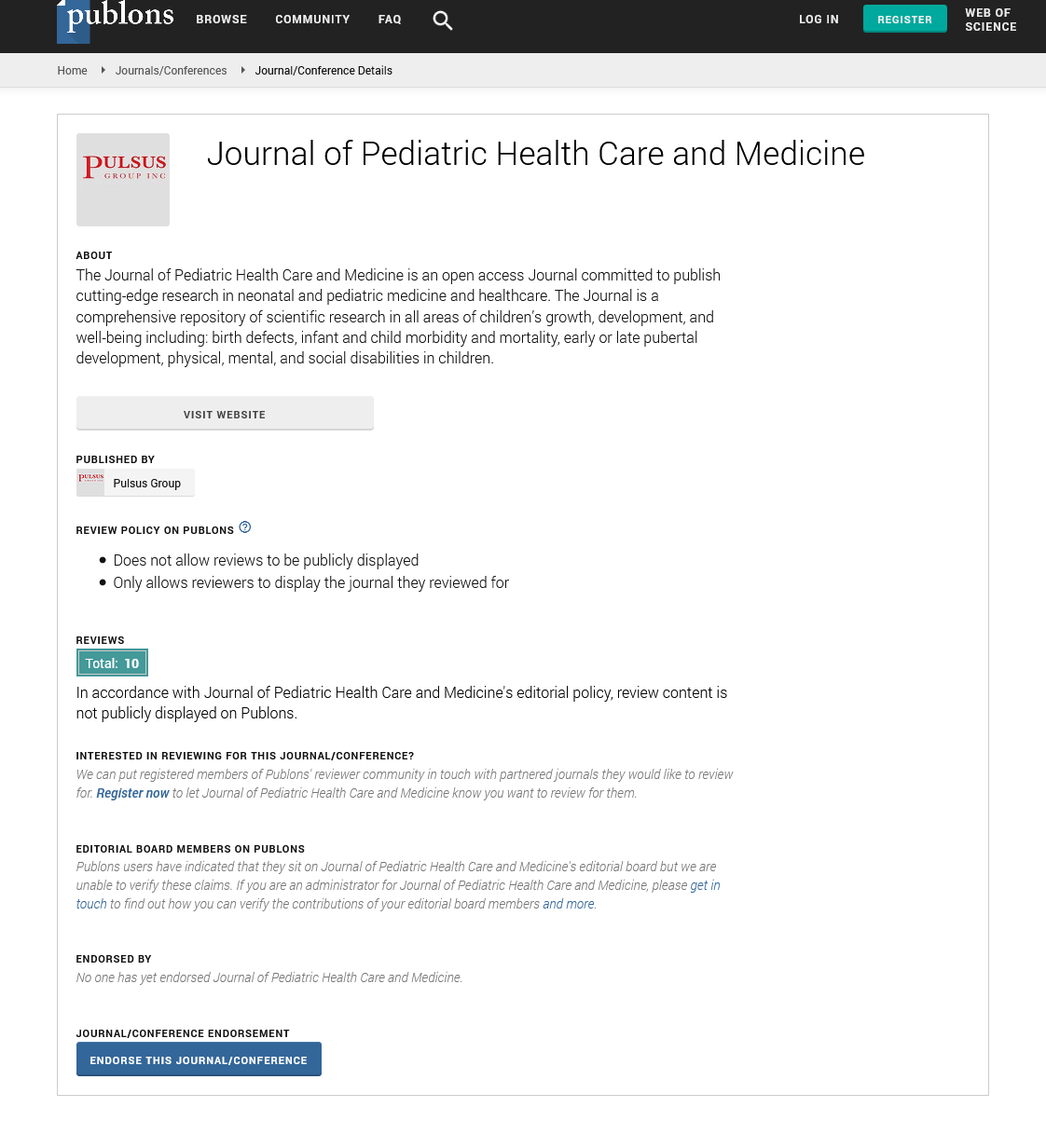Surgical Management of Vascular Stents in Pediatric Cardiac Surgery: Clues for a Staged Partnership
Received: 28-Nov-2017 Accepted Date: Dec 05, 2017; Published: 12-Dec-2017
Citation: Gil-Jaurena JM. Surgical Management of Vascular Stents in Pediatric Cardiac Surgery: Clues for a Staged Partnership. J Pedia Health Care Med 2017;1(1):8-9.
This open-access article is distributed under the terms of the Creative Commons Attribution Non-Commercial License (CC BY-NC) (http://creativecommons.org/licenses/by-nc/4.0/), which permits reuse, distribution and reproduction of the article, provided that the original work is properly cited and the reuse is restricted to noncommercial purposes. For commercial reuse, contact reprints@pulsus.com
Letter to Editor
In December 2015, a paper was launched in Pediatric Cardiol with the topic [1] above mentioned. The authors collected data along two consecutive years in a prospective manner, gathering 35 patients who had 46 stents previously deployed. Univentricular heart was prevalent (20 cases) and right ventricular outflow tract (RVOT) with left pulmonary artery (LPA) were the most often stented sites (28 stents, altogether). On the other hand, transplants, Fontan and Glenn plus conduit replacement accounted for nearly 80% of the surgical procedures. Interestingly, partial versus total stent removal was registered, and “straightforward” as opposed to “difficult” was considered on taking deep hypothermia plus circulatory arrest as a surrogate for complexity. The article concluded with a sort of algorithm based on surgical diagnosis, stent location and uni/biventricular repair.
Our current database spans five years, from January 2013 to December 2017. Seventy-seven (77) patients have been enrolled, presenting ninety-seven (97) stents in several locations. Some of the previous statements have been reassured:
1. Certain patients show more than one stent, often times deployed at different stages.
2. The more surgical or cath-lab procedures children undergo, the more chances to carry a stent at a latest surgery. Thus, univentricular pathway (at Glenn, Fontan or transplant stages) and right-ventricle-to-pulmonarybranches (RV to PA) conduit replacement (Truncus, Rastelli, Ross, etc.) are most cited among pre-surgical diagnosis (approaching 80%)
3. As a recently adopted strategy (RVOT stent in neonates with hypoxic spells), Fallot repair including RVOT stent removal is gaining acceptance.
4. According to location, LPA (27 stents) and RVOT (24 stents) take the lead as a cluster, reaching more than 50% of stent sites.
Partial or total retrieval is no longer a matter of debate. About one third of stents are left in place (edge severing, side splitting) mainly in the pulmonary branches, unless full removal becomes necessary. LPA stent in a Glenn to Fontan patient needs to be trimmed just to fix the extra cardiac conduit in the anastomoses. On the other hand, the “same patient” in the Fontan to transplant scenario will have the LPA stent completely removed before implanting the new graft. Our data reflects that 50% of stents in pulmonary branches are fully retrieved, whereas the remaining 50% are partially removed in a custom way.
A hybrid approach has been implemented along with partial removal of stents in both pulmonary arteries: balloon enlargement of retro-aortic stents, either LPA in Fontan, either right PA in Rastelli/Truncus setting.
One third of patients are deemed difficult to have their stents removed. Arbitrarily, deep hypothermia plus circulatory arrest are surrogate parameters for complexity. Vascular structures most difficult to reach are the inferior vena cava and both pulmonary arteries, because their deep location within the chest. Not surprisingly, transplant surgery (particularly in univentricular hearts, after Glenn and Fontan procedures) stands for the paradigm of challenge when stent removal in LPA and inferior vena cava (IVC) are required. In the former patients, removal of stents in the IVC is accomplished after taking off the cannula in a low-flow setting (circulatory arrest).
On the contrary, stent removal in RVOT and atrial septal defects (ASD) is considered fairly simple, adding little time to the procedure.
Ductal stenting deserves special attention. Most cases, fostering Fallot or Rastelli procedures, are easily handled with sternal clips at surgical repair. After a neonatal hybrid procedure, including ductal stenting plus bilateral banding, the stented ductus becomes the “new arch” awaiting further surgeries. This holds true for two patients who underwent a “comprehensive” repair (Norwood plus Glenn), one infant with a Yasui procedure (Norwood plus Rastelli) and two transplants (in whom the diminutive aorta was replaced by the donor´s arch [2], separately) All five cases had their ductal stent completely removed under deep hypothermia and circulatory arrest before getting their new aorta rebuilt in a Norwood-like fashion.
Anticoagulation can become an issue after thorough debridement of stents in thin-walled vessels, particularly both pulmonary branches. Some of our patients referred for conduit replacement (from RV to PA) and biological valves in pulmonary position (besides stent handling in LPA and/or RPA) are already on aspirin. We arbitrarily decided to follow the same anti-platelet regime for patients who have their stents fully removed from pulmonary arteries. Interestingly, most patients undergoing transplant surgery [3] have their stents in LPA retrieved, Glenn and Fontan anastomosis taken-down and a thorough reconstruction with donor pericardium is carried out from hilum to hilum. Aspirin seems sensible in this scenario.
Conclusion
1. Cardiologists do not hesitate on deploying stents because surgeons have learnt how to handle them. An increase in stent placement and, hence, surgical removal is expected in complex and staged procedures.
2. Stent location alone is not the clue for surgery. Previous diagnosis, scheduled surgery (paliation/repair, uni/biventricular, etc.) play a role in the decision algorithm. Partial removal plus balloon dilatation may prove useful in retro-aortic stents not amenable to retrieval.
3. Anticipate for short periods of deep hypothermia & circulatory arrest in distant stents to be totally removed (inferior vena cava, left pulmonary artery), particularly in transplant surgery.
Some data to keep in mind
77 patiens had 97 stents removed along five consecutive years (2013-7).
Nearly 50% of the procedures (35) were carried out in a univentricular setting (including 17 Transplant and 18 Glenn/Fontan patients).
About 30% cases (23) pertained to conduit replacement (RV to PA)
Fallot repair (with RVOT stenting) is a new strategy, reaching 10% (11 infants).
Most often sites stents were deployed are LPA (27) and RVOT (24), raising to 50% of overall locations
One third of stents (28) are partially removed..
One third of stents (33) are difficult to retrieve (deep hypothermia plus circulatory arrest are requested).
50% of overall stents in LPA & RPA are partially removed.
50% of LPA & RPA stents are handled straightforward.
100% IVC stents are totally removed in deep hypothermia and decannulation.
REFERENCES
- Gil-Jaurena JM, Zunzunegui JL, Pérez-Caballero R, et al. Surgical management of vascular stents in pediatric cardiac surgery: Clues for a Staged Partnership. Pediatr Cardiol 2015;36:1685-1691.
- Split-graft technique in neonatal heart transplant for aortic atresia. Gil- Jaurena JM, González-López MT, Pita-Fernández A, Pérez-Caballero R. Interact Cardiovasc Thorac Surg. 2016;23(4):659-61.
- Trasplante después del Fontan. Aspectos quirúrgicos. Gil-Jaurena JM, Camino M, Pérez-Caballero R, Pita A, González-López MT, Zunzunegui JL, Gil-Villanueva N, Medrano C. Cir Cardiovasc 2016;23(5):234-9.






